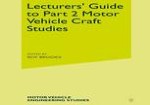1983 | Buch
Lecturers’ Guide to Part 2 Motor Vehicle Craft Studies
Transmission, Chassis and Materials
verfasst von: John Whipp
herausgegeben von: Roy Brooks
Verlag: Macmillan Education UK
Buchreihe : Repair and Servicing of Road Vehicles Macmillan Series
Enthalten in: Professional Book Archive
